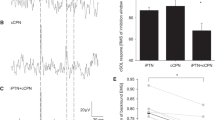Abstract
The size of the soleus Hoffmann reflex (H-reflex) was measured in six healthy human subjects before and after transmission in the common peroneal nerve (CPN) was blocked reversibly by local injection of lidocaine. It was found that the H-reflex at rest increased after the block. When the subjects attempted to perform a dorsiflexion while the CPN was blocked (“fictive dorsi flexion”), the soleus H-reflex was strongly depressed. Stimulation of the CPN proximal to the block elicited a short-latency inhibition of the soleus H-reflex, which was probably mediated by reciprocal Ia interneurones. This inhibition never increased during dorsiflexion relative to rest prior to the CPN block, but after the block a significant increase in inhibition was seen during fictive dorsiflexion in three subjects. Stimulation of the femoral nerve (FN) elicited a short-latency monosynaptic Ia facilitation of the soleus H-reflex. This facilitation was found to decrease during dorsiflexion relative to rest before the block as well as during fictive dorsiflexion after the block. The decrease in the H-reflex during fictive dorsiflexion demonstrates that although an increased Ia afferent feedback via the gamma-loop may contribute to reciprocal inhibition when transmission in the CPN is intact, a noticeable, centrally mediated inhibition may occur in the absence of this feedback. It is suggested that this inhibition is caused by central facilitation of interneurones mediating disynaptic Ia inhibition as well as interneurones mediating presynaptic inhibition of Ia afferents.
Similar content being viewed by others
References
Baldissera F, Hultborn H, Illert M (1981) Integration in spinal neuronal systems. In: Brooks VB (ed) Motor control. (Handbook of physiology, sect 1, The nervous system, vol 2) Am Physiol Soc, Bethesda, Md. pp 509–595
Ballegaard M, Hultborn H, Illert M, Nielsen J, Paul A, Wiese H (1991) Slow passive stretches of a muscle depresses transmission of its monosynaptic reflex. Eur J Neurosci [Suppl] 4: 298
Crone C, Nielsen J (1989a) Spinal mechanisms in man contributing to reciprocal inhibition during voluntary dorsiflexion of the foot. J Physiol (Lond) 416: 255–272
Crone C, Nielsen J (1989b) Methodological implications of the post activation depression of the soleus H-reflex in man. Exp Brain Res 78: 28–32
Crone C, Hultborn H, Jespersen B (1985) Reciprocal Ia inhibition from the peroneal nerve to soleus motoneurones with special reference to the size of the test reflex. Exp Brain Res 59: 418–422
Crone C, Hultborn H, Jespersen B, Nielsen J (1987) Reciprocal Ia inhibition between ankle flexors and extensors in man. J Physiol (Lond) 389: 163–185
Crone C, Hultborn H, Mazieres L, Morin C, Nielsen I, Pierrot-Deseillgny E (1990) Sensitivity of monosynaptic test reflexes to facilitation and inhibition as a function of the test reflex size: a study in man and the cat. Exp Brain Res 81: 35–45
Forget R, Hultborn H, Meunier S, Pantieri R, Pierrot-Deseilligny E (1989) Facilitation of quadriceps motoneurones by group I afferents from pretibial flexors in man. 2. Changes occurring during voluntary contraction. Exp Brain Res 78: 21–27
Gandevia SC, Burke D, McKeon B (1986) Coupling between human muscle spindle endings and motor units assessed using spike-triggered averaging. Neurosci Lett 71: 181–186
Hoffmann P (1918) Über die Beziehungen der Sehnenreflexe zur willkürlichen Bewegung. Zeitschrift für Biologie 68: 351–370
Hultborn H, Meunier S, Morin C, Pierrot-Deseilligny E (1987) Assessing changes in presynaptic inhibition of Ia fibres: a study in man and the cat. J Physiol (Lond) 389: 729–756
Iles JF (1986) Reciprocal inhibition during agonist and antagonist contraction. Exp Brain Res 62: 212–214
Iles JF, Pisini JV (1992) Cortical modulation of transmission in spinal reflex pathways of man. J Physiol (Lond) 455: 425–446
Kagamihara Y, Tanaka R (1985) Reciprocal inhibition upon initiation of voluntary movement. Neurosci Lett 55: 23–27
Kernell D, Hultborn H (1990) Synaptic effects on recruitment gain: a mechanism of importance for the input-output relations of motoneurone pools. Brain Res 507: 176–179
Kots IM (1969) Supraspinal control over segmental centers of muscle antagonists in man. I. Reflectory excitability of muscle antagonist motor neurons during voluntary movement. Biofizika 14: 167–172
Kots IM, Zhukov VI (1971) Supraspinal control of the segmental centres of muscle antagonists in man. III. “Tuning” of the spinal apparatus of reciprocal inhibition in the period of organization of voluntary movement. Biofizika 16: 1085–1091
Lundberg A (1970) The excitatory control of the Ia inhibitory pathway. In: Andersen P, Jansen JKS (eds) Excitatory synaptic mechanisms. Universitetsforlaget, Oslo, pp 333–340
Mendell LM (1984) Modifiability of spinal synapses. Physiol Rev 64: 260–325
Meunier S, Morin C (1989) Changes in presynaptic inhibition of Ia fibres to soleus motoneurones at the onset of voluntary dorsiflexion of the foot. Exp Brain Res 76: 510–518
Morin C, Pierrot-Deseilligny E (1977) Role of Ia afferents in the soleus motoneurones inhibition during a tibialis anterior voluntary contraction in man. Exp Brain Res 27: 509–522
Nielsen J, Kagamihara Y (1993a) Differential projection of the sural nerve to early and late recruited tibialis anterior motor units: change of recruitment gain. Acta Physiol Scand 147: 385–401
Nielsen J, Kagamihara Y (1993b) The regulation of presynaptic inhibition during co-contraction of antagonistic muscles in man. J Physiol (Lond) 464: 575–593
Nielsen J, Kagamihara Y, Crone C, Hultborn H (1992) Central facilitation of Ia inhibition during tonic ankle dorsiflexion revealed after blockade of peripheral feedback. Exp Brain Res 88: 651–656
Nielsen J, Petersen N, Deuschl G, Ballegaard M (1993) Task-related changes in the effect of magnetic brain stimulation on spinal neurones in man. J Physiol (Lond) 471: 223–243
Simoyama M, Tanaka R (1974) Reciprocal Ia inhibition at the onset of voluntary movements in man. Brain Res 82: 334–337
Vallbo ÅB (1970) Discharge patterns in human muscle spindle afferents during voluntary contraction. Acta Physiol Scand 80: 552–567
Vallbo ÅB, Hagbarth K-E, Torebjörk HE, Wallin BG (1979) Somatosensory, proprioceptive, and sympathetic activity in human peripheral nerves. Physiol Rev 59: 919–957
Author information
Authors and Affiliations
Rights and permissions
About this article
Cite this article
Nielsen, J., Crone, C., Sinkjær, T. et al. Central control of reciprocal inhibition during fictive dorsiflexion in man. Exp Brain Res 104, 99–106 (1995). https://doi.org/10.1007/BF00229859
Received:
Accepted:
Issue Date:
DOI: https://doi.org/10.1007/BF00229859




